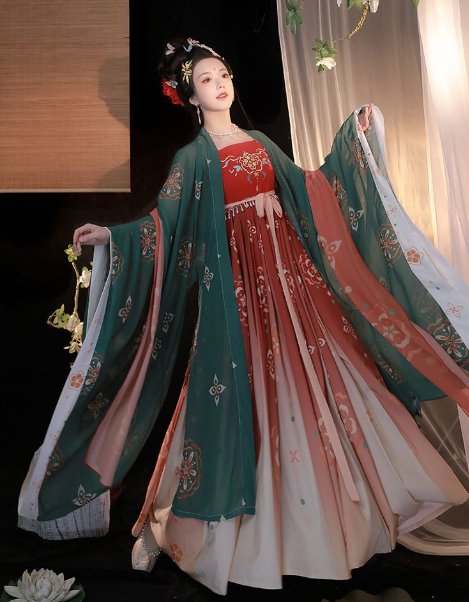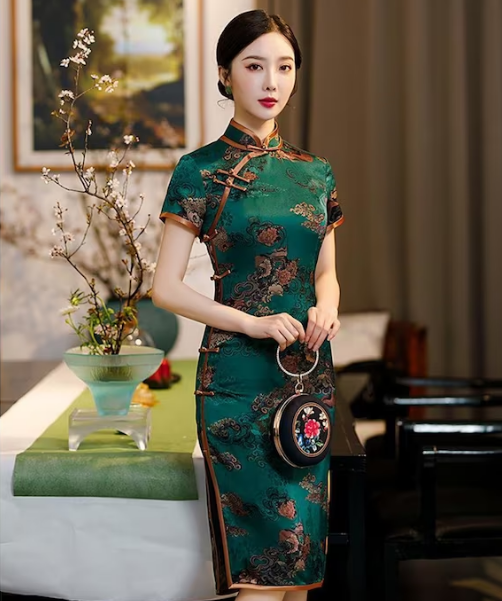Chinese traditional dress includes Hanfu, Qipao, and distinct ethnic and regional styles.
Overview of Chinese Traditional Dress
Chinese traditional dress, a splendid tapestry of history and culture, embodies the artistic achievements and philosophies of ancient China. These garments, far more than mere attire, represent a deep cultural heritage. They have evolved over centuries, influenced by various dynasties and regions, reflecting the aesthetics and values of different eras.
Historical Development
The history of Chinese traditional dress dates back to the Shang Dynasty, around 1600 BC. Initially, clothing was simple, designed for practicality in agricultural activities. However, as society progressed, clothing became a symbol of status and identity. During the Zhou Dynasty, strict dress codes based on social hierarchy were established. This period saw the emergence of the ‘Hanfu’, the most iconic traditional Chinese attire, which is often associated with the Han ethnicity.

As dynasties changed, so did fashion. The Tang Dynasty introduced vibrant colors and wide sleeves, reflecting an era of openness and cultural exchange. The Song Dynasty favored more restrained and elegant styles, illustrating the era’s emphasis on scholarly refinement. The Ming Dynasty resurrected Hanfu styles, but with added sophistication in fabric and design.
The Qing Dynasty brought about the most significant change with the introduction of the ‘Qipao’ or ‘Cheongsam’. Initially a loose-fitting dress, it evolved into the form-fitting version popular today. The Qipao became a symbol of modernity and is often seen as a representation of female empowerment.
Cultural Significance
Chinese traditional dress is not merely about fabric and patterns; it is imbued with rich symbolism and philosophical ideas. Colors in traditional Chinese attire are deeply symbolic. Red, representing happiness and good fortune, is often worn during festivals and weddings. Green symbolizes growth and harmony, while blue reflects calmness and stability.
Patterns on traditional dresses are also significant. Dragons, phoenixes, and lotus flowers are not just decorative elements; they carry deep meanings. Dragons symbolize power and strength, phoenixes denote renewal, and lotus flowers represent purity and enlightenment.
In modern times, traditional Chinese dress has seen a resurgence, blending ancient styles with contemporary fashion. This fusion symbolizes the dynamic and evolving nature of Chinese culture. Designers are incorporating traditional elements into modern clothing, making it relevant to the younger generation and promoting cultural pride.
Traditional Chinese dress, with its rich history and cultural significance, stands as a testament to the enduring legacy of Chinese civilization. It is not just clothing; it is a narrative of the Chinese spirit, woven through the threads of time.
Components of the Qipao (Cheongsam)
The Qipao, also known as Cheongsam, stands as an iconic symbol of Chinese fashion, combining elegance and grace with cultural significance. Originating from the Qing Dynasty, it has evolved into a modern representation of traditional aesthetics. The Qipao is not just a dress; it’s an art form that encapsulates the essence of Chinese craftsmanship and design philosophy.
Fabric and Materials
Traditionally, Qipao was made from silk, exemplifying luxury and social status. Today, designers use a variety of materials, ranging from cotton for everyday wear to luxurious brocades for formal occasions. Silk remains popular for its sheen and elegance, often featuring intricate embroideries of floral or dragon motifs. Designers also experiment with blends like silk and cotton for comfort, along with satin and velvet for a richer texture. The choice of fabric plays a crucial role in the garment’s appearance, drape, and feel, making each Qipao unique.
Collar Types
The collar of a Qipao is not just a design element but a reflection of cultural values. The most common type is the Mandarin collar, a high-standing, stiff collar that symbolizes elegance and modesty. Some variations include rounded collars, which offer a softer appearance, and keyhole necklines for a touch of modernity. The collar’s height and shape can significantly alter the Qipao’s overall look, balancing tradition with contemporary fashion sensibilities.
Sleeve Variations
Sleeves in Qipao designs vary widely, reflecting changes in fashion and functionality. Traditional Qipaos featured long, fitted sleeves, signifying grace and femininity. Modern designs incorporate short sleeves for practicality and comfort, especially in warmer climates. Cap sleeves provide a youthful and playful look, while sleeveless designs offer a modern, chic appeal. The sleeve style significantly affects the garment’s silhouette and is often chosen based on the occasion and wearer’s preference.
Slit and Length Styles
The Qipao is renowned for its distinctive slits, varying in length and number. Originally, the slits were practical, allowing for easier movement. Today, they add a stylish edge to the dress. Side slits can extend up to the thigh, offering a glimpse of leg that adds to the dress’s allure. The length of the Qipao also varies, from the traditional floor-length for formal events to the popular knee-length for everyday wear. Shorter styles, which emerged in the 20th century, reflect Western influences and modern fashion trends.
Each element of the Qipao, from fabric to slit style, intertwines to create a garment that is not just a piece of clothing but a statement of cultural identity and aesthetic preference. The evolution of the Qipao mirrors the dynamic nature of Chinese culture, blending tradition with modernity in a seamless fashion tapestry.
Elements of the Hanfu
Hanfu, the traditional attire of the Han Chinese, is a symbol of ancient Chinese culture and aesthetics. This elegant and flowing garment has a history spanning over three millennia and reflects the artistic and social values of ancient China. Its components, rich in cultural significance, include the upper garment (Yi), lower garment (Chang), overcoat (Pao), and various accessories.
Upper Garment (Yi)
The Yi is the upper garment of the Hanfu, often characterized by its cross-collar design. This garment typically wraps around the body, with the right lapel over the left, a style rooted in ancient Chinese customs. The Yi varies in length and sleeve width, with some designs featuring wide, flowing sleeves that demonstrate the wearer’s grace. The fabric choice, often silk or brocade, adds to the garment’s elegance, with colors and patterns reflecting the wearer’s status and occasion.
Lower Garment (Chang)
The Chang refers to the lower part of the Hanfu, which can be a skirt or pants. Skirts are more common in traditional women’s Hanfu, with pleats or panels that create a flowing silhouette. Pants, typically worn by men, are wide and loose, allowing for ease of movement. The Chang’s length and style can vary, with longer skirts for formal occasions and shorter ones for everyday activities.

Overcoat (Pao)
The Pao is an overcoat worn over the Yi and Chang. It can be full-length, reaching the knees or even the ankles, and is often used in formal and ceremonial attire. The Pao adds an extra layer of sophistication to the Hanfu ensemble, with luxurious fabrics and intricate embroidery that display the wearer’s wealth and social standing. The style of the Pao, including its sleeve and collar design, can vary significantly, each reflecting a different aspect of Chinese culture and fashion.
Accessories (Belts, Scarves, etc.)
Accessories play a crucial role in completing the Hanfu ensemble. Belts, often made of silk or brocade, are used to cinch the waist and add structure to the garment. They can be simple or ornate, with intricate designs and tassels. Scarves and shawls, usually made of light, airy fabrics, add an extra layer of elegance, often draped over the shoulders or around the neck. Headwear, such as hats and hairpins, is also significant, especially in formal attire, where they signify the wearer’s social status and marital status.
Each element of the Hanfu, from the Yi to the accessories, is a testament to the rich cultural heritage of ancient China. These garments are not just clothing; they are a form of cultural expression, representing centuries of tradition, art, and social customs. The resurgence of Hanfu in modern times reflects a growing appreciation for China’s cultural heritage and a desire to connect with the ancient aesthetics of the Han people.
Regional Variations in Traditional Dress
Traditional Chinese dress reflects a vast tapestry of regional diversities, influenced by geography, climate, and cultural interactions. From the distinct styles of Northern and Southern China to the rich tapestries created by ethnic minorities, these variations represent a deep well of cultural richness. Contemporary adaptations further add to this diversity, blending ancient motifs with modern fashion sensibilities.
Northern vs. Southern Styles
The traditional dresses of Northern and Southern China differ significantly due to climatic and cultural factors. In the North, where the climate is colder, clothing tends to be heavier and more robust. Thick fabrics like wool and padded linings are common, providing necessary warmth. In contrast, the South, with its warmer and more humid climate, favors lighter materials like silk and cotton. The designs in the South are often more vibrant, reflecting the region’s lush landscapes and diverse flora.
Comparison Table: Northern vs. Southern Styles
| Aspect | Northern Styles | Southern Styles |
|---|---|---|
| Fabric | Heavier (Wool, Padded Linings) | Lighter (Silk, Cotton) |
| Colors | Muted, Darker Shades | Vibrant, Brighter Tones |
| Design | More Conservative and Robust | More Elegant and Flowing |
| Adaptation to Climate | Warm and Protective | Light and Airy |
| Cultural Influences | Reflects Mongolian and Manchurian Heritage | Influenced by Maritime Trade and Tropical Environment |
Ethnic Minority Influences
China’s ethnic minorities contribute immensely to the tapestry of traditional dress. Each group, with its unique cultural identity, brings a distinct style and aesthetic to the fore. For example, the Miao people are renowned for their intricate silver jewelry and vibrant embroidery. The Tibetan traditional dress is characterized by its bold colors and heavy fabrics, suitable for the harsh Himalayan climate. These ethnic styles not only add to the richness of China’s cultural fabric but also tell the stories of diverse peoples and their histories.

Contemporary Adaptations
Modern designers are reinterpreting traditional Chinese dresses with a contemporary twist. They blend ancient motifs with new materials and techniques, creating garments that honor the past while embracing the future. These adaptations often feature a fusion of styles, such as combining the elegance of the Qipao with Western dress cuts, or integrating traditional embroidery into modern silhouettes. This ongoing evolution reflects the dynamic nature of Chinese culture, constantly adapting and growing while staying rooted in its rich heritage.
The regional variations in traditional Chinese dress underscore the diversity and richness of China’s cultural landscape. From the warmth of Northern attire to the elegance of Southern styles, and from the unique contributions of ethnic minorities to the innovative contemporary adaptations, these garments are more than just clothing. They are a vivid expression of history, culture, and identity.